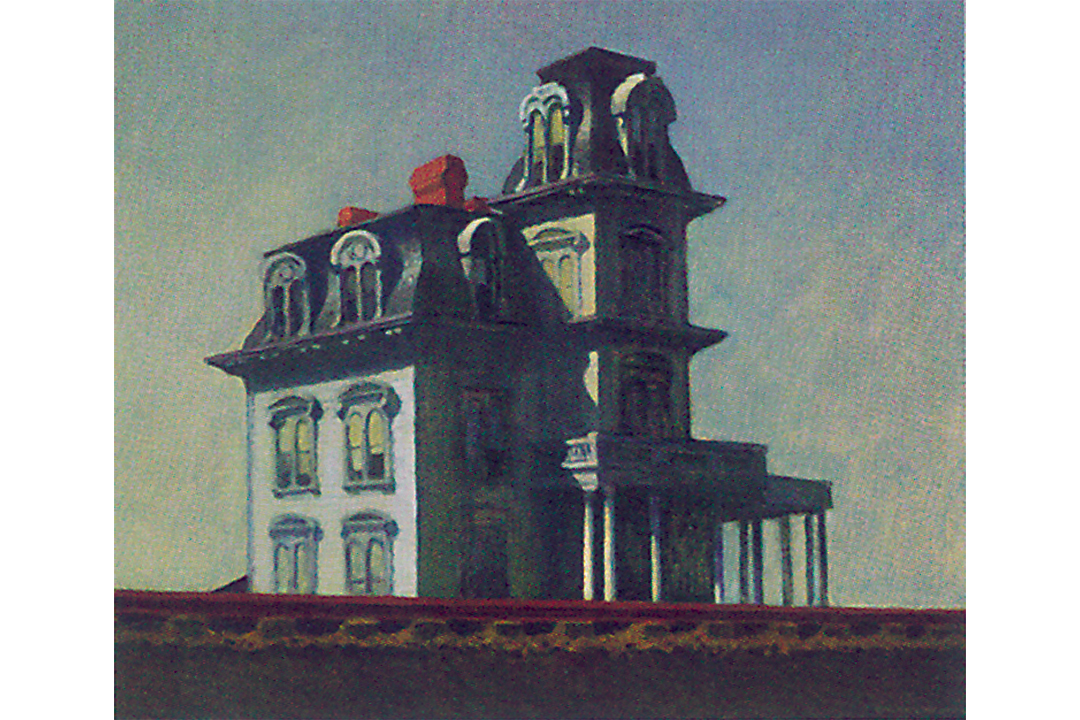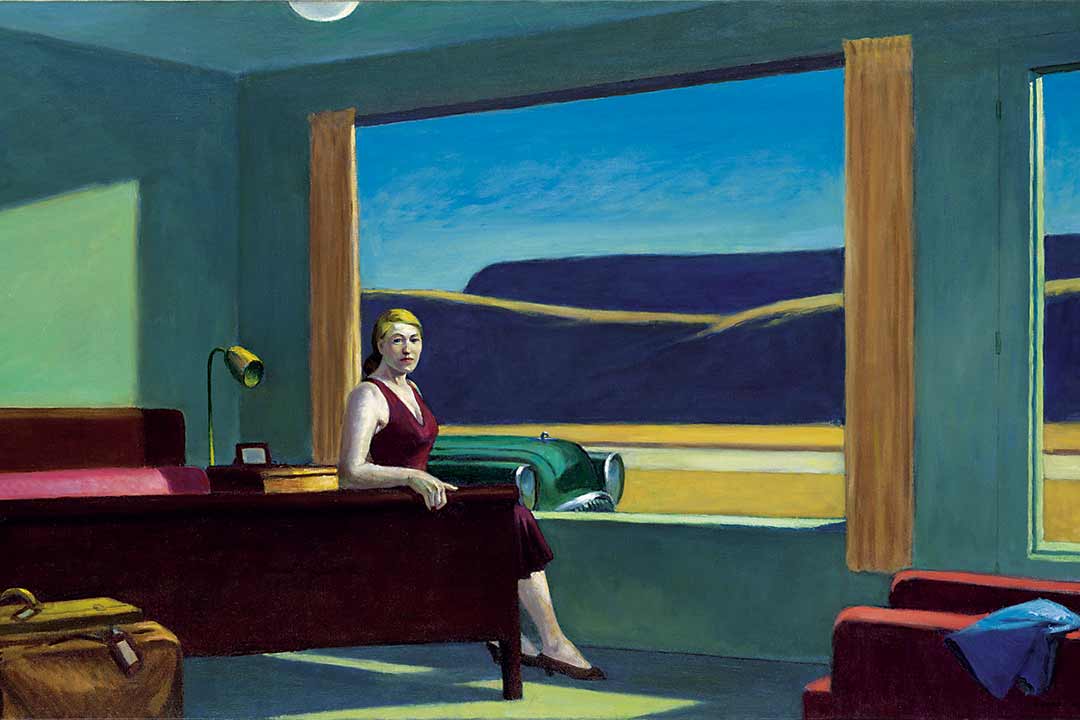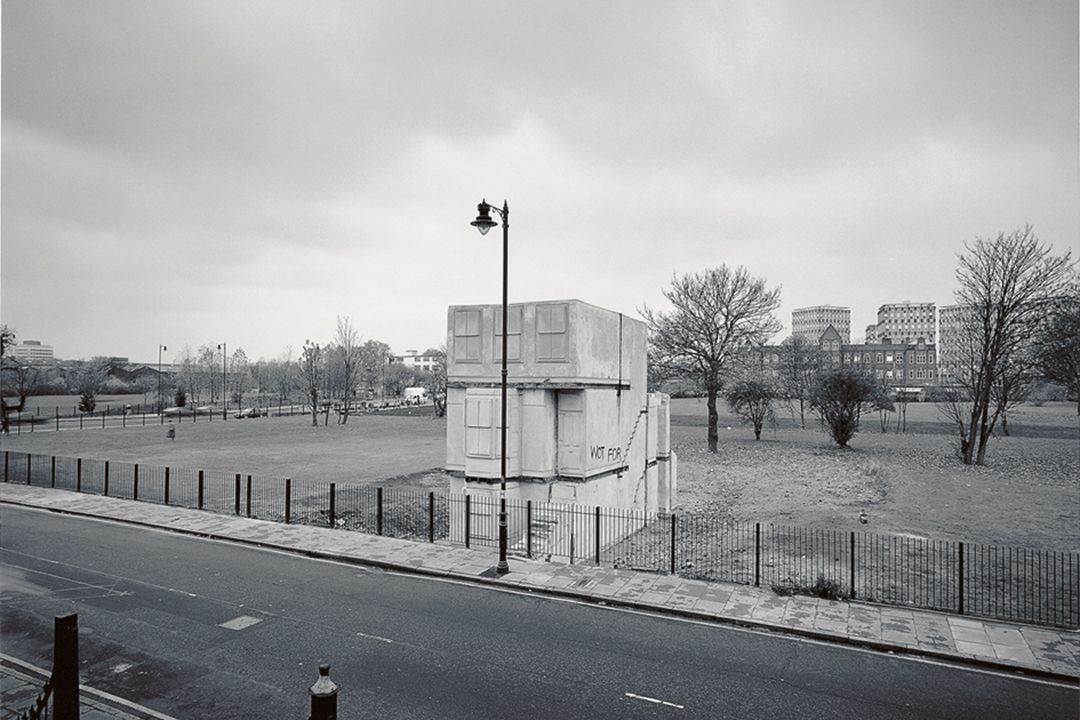The American painter Edward Hopper, who was introduced to the Viennese audience at an exhibition in the Kunsthalle at the beginning of October 2008, was known as being very familiar with the medium of film. He died in 1967, when he was 85 years old, and left behind a great number of canvasses displaying obscure rooms and houses, most often solitary, which could (and did) serve as an excellent ambience solution for scenery in films noirs of his time and later. Seven years prior to the painter’s death, the master of thrillers, Alfred Hitchcock, had mentioned that Hopper’s 1925 painting (House by the Railroad) served as the model for the Gothic house on the hill in Psycho[1]. Norman Bates (Anthony Perkins) would run every now and then into the house in order to have heated arguments with his dead mother about the female guests of his motel.
Regardless of the fact that the ‘house’ connection between the painter and director has not been confirmed with certainty even today, everyone who has watched Psycho and had the opportunity to see Hopper’s house by the railroad can confirm a great similarity and say something in support of the alleged connection. The architectural assembly in the painting is identical to the one in the film, with slight differences in the windows and chimneys which are, naturally, presented more luxuriously on the canvas. Here, one should bear in mind that the canvas is a full 35 years older than the frames on the screen. Lack of detail on the roofing was compensated by Hitchcock’s crew with the dynamically indented approach to the building – the stairs which Norman Bates would take to climb to the house on the hill in order to get his dead mother’s advice. There is no access stairway in Hopper’s painting, merely a horizontal of the railway, which intersects the ground floor of the house. A worm’s eye view of the film screen had its epilogue in the form of indented stairways. It is obvious that the director and painter, each in his own way, looked for obscure solutions for the Gothic house. The painter set it on a plain, and enforced its Gothic effect with a low-angle viewpoint. In Psycho, a similar function – the creation of an intimidating and morbid atmosphere – was given to the indented staircase at the base of the building on the hill. The director, undoubtedly, recognized the scheme of future film architecture in the painting strategy of Edward Hopper.

Certainly, Hitchcock is not the only director, or film maker, who used Hopper’s reconstructed reality in a productive manner. The exhibition in the Kunsthalle in Vienna used numerous examples of contemporary artistic practice to show in what ways less exposed patterns of American realistic painting, practised in the period before and after the Second World War, have dealt quite well with recent strategies in art almost half the century after the artist died. A big admirer of the American painter is also German director Wim Wenders. He openly speaks of how he used to cut out reproductions of Hopper’s paintings from catalogues and use them for setting scenes in his own films[2]. In a text, published in Die Zeite in 1996 and printed in the catalogue that accompanied the exhibition in Vienna, the German director claims that almost all scenes in Hopper’s paintings could be part of a big film about America – each at the beginning of a new chapter[3].
Gustav Deutsch, born in 1952, an artist who studied architecture at Vienna University during the seventies, was thinking in a similar manner. He is one of fifteen contemporary authors who were invited to demonstrate the influence of the American painter on contemporary artistic practice with their works, exhibited in Hall 1 at the Kunsthalle. With the help of associates from the Viennese institution, he reconstructed the ambience of Hopper’s painting Western Motel, after which the exhibition was named, and installed a video camera there. Prior to entering the exhibition hall, visitors were able to see the still ambience of Western Motel live on a video screen. Later on, in the hall itself, they were able to enter this ambience and thus take the place of the female figure who is sitting on the edge of bed and waiting in the Hopper’s painting. The painter’s model for the motel guest, as on many other occasions – on the beds of numerous hotel rooms, at the door of a solitary house, in a cinema auditorium, etc. – was his wife Josephine (Jo). The frequent appearance of a female figure in a sparsely furnished room in which windows are important elements of fictive – extended – reality, forced the 56-year-old Viennese artist to transform Hopper’s painting into a film story. Along the line of Wenders’ idea of how the American’s canvasses could cover more significant chapters in a possible film version of the American way of life, he chose fifteen scenes which became key scenes of a future film about the life story of an imaginary actress, Shirley. He singled out fifteen of Hopper’s paintings to summarize different phases in the actress’s life in a short time sequence from 28 August (7 am) to 29 August (7 pm). Since Hopper was especially sensitive about time (he even named individual scenes on canvasses after specific times of the day or night), the Viennese artist was able to squeeze the actress’s life into a period of only 36 hours without great difficulty. He presented the film project with a precise plan on 15 photocopies – one colour copy for each painting – and with miniature models of rooms which are based on the chosen Hopper canvasses. Deutsch’s staging very clearly indicates how simple sceneries on canvasses can transform into real spatial riddles and puns at the point when there is an attempt to transform them into live, three-dimensional ambiences. Miniature motel rooms suffer from constructional irregularities, but at the same time reveal spatial mysteries because of which the American was so attractive to film makers around the world. Not only to Alfred Hitchcock, Wim Wenders or Jim Jarmusch[4], but also to those authors who present their solutions on film for the most part under the arched ceilings of galleries and museums; in other words, to authors who are looking for new, extended solutions for painting work in film strategies.

At the beginning of Hopper’s career nothing indicated that his realism in painting would be of interest to generations of artists in the first decade of the third millennium. Few could foresee that simple presentations of motel rooms, gas stations or a number of identical buildings with apartments would draw enormous attention among artists and film theoreticians. Few thought about that in the period of surrealism, or New York’s ‘Armory Show’ exhibition[5], or during the sixties when trends in painting turned to geometrical optics. Few could assume that the weakened balance of the painting medium would be remedied by film means at the end of the century. Hopper was silent and patiently painted scenes coloured in surrealistic colours, scarce in narration and mysterious. The characters, if they happened to find themselves on the painting ‘set’ are also silent. Motionless, like marionettes, with an expression of hopelessness on their faces, similar to a piece of furniture or scenery, somewhere in mid-shot – at a decent distance from the painter, certainly not too close or too far away. The canvasses leave the impression of frozen film frames. On the other hand, the suggestion of film movement is indicated by frequent presentations of identical architectural units in a sequence. Apart from solitary houses and unusual camera angles which more resemble an illustrator[6] or camera man, Hopper also showed interest in monotonous sequences of buildings on the outskirts of a city[7].
Schemes on canvas which can easily transform into movement at any moment and vice versa – when artists ‘dramatically’ push the boundaries of the film medium and slow down its cinematicity – are strategies which linked Hopper’s name to those of Jonas Dahlberg (born in 1970) and David Claerbout (born in 1969) at the exhibition in Vienna. Both authors, the Swede and the Belgian, use static frames. Almost nothing was happening on the screens and it seemed that the image was still. However, with the passing minutes, one could notice changes on three of Dahlberg’s screens and this in the contours of Three Rooms (2008). Before the patient spectator’s eyes, the furniture in the kitchen, dining room and bedroom slowly disintegrates and disappears. The sun patterns there irresistible recall the light patterns in Hopper’s canvases. The time sequence in Claerbout’s two-channel ‘thriller’ also thwarts passive frames on both screens. One of the heads of the two ‘detectives’ moves, while they are sitting in the car and watching rain pouring down onto the windscreen on the first screen or a branch of the tree in the middle of wasteland trembles occasionally on the second screen[8]. Both authors deliberately fogged cinematic values of the film medium with which they in fact stretched a very thin and delicate connection with the tradition of realism in painting. In the age of new technologies, when artists are competing as to who will disturb to greater extent the credibility of one of the numerous media which are available to them, the American painter seems to be taking a significant historical place. He realized at an early stage, still in the time of European surrealism, the importance of film. His need to find a break from painting in the darkness of the cinema auditorium helped him, perhaps even unconsciously, to reset realistic images of American architecture to schemes which are more comprehensible to generations of new artists than they were to his contemporaries. He explained, in the spirit of his time, these schemes as his own psychographs. One of the more impressive psychographs at the exhibition in Vienna was the concrete cast of the interior of an old London house on a site in the East End at the end of 1993. It was created by 1993 Turner Award winner, Rachel Whiteread, who realized this with the technical help of construction workers. The bleak building without any window openings stood on the London site until the beginning of the following year – 1994 – when it was completely removed. While the building was there, one could see that it had a reverse relief of window openings. The concrete building was similar to Hopper’s drawing of a solitary house from back in 1922. Although in form it was closer to a bunker than a Gothic house, it left a Gothic impression while it was standing on its site. Although Rachel’s psychograph in Vienna was presented in the form of a video diary, it is a good example of how the boundaries of realism in art (painting) do not have to be refined and broadened exclusively by photographic or film means[9].

[1] The data is mentioned in an official biographical card, printed in the catalogue for the exhibition ‘Western Motel. Edward Hopper and Contemporary Art’ (Kunsthalle Vienna, Gerald Matt, 2008, p. 281). The same catalogue includes a text entitled ‘Hopper’s Window’ in which Thomas Macho doubts the reliability of this data, although he supports the painter’s influence on films Psycho and Rear Window (1954). He even wonders – thus adding fuel to the flames – whether the painter’s painting from 1919 (Stairway) served as the model for the stairway in the interior of the Gothic house where Hitchcock’s private detective (Arbogast) found his death (p. 17).
[2] As events to accompany the exhibition, several films were scheduled in the repertoire of Viennese Top Cinema, among them Wenders’ Don’t Come Knocking from 2005. Hopper’s influence is recognizable in the scenography of rooms, camera angles and the importance which the German director assigns to windows. The most impressive connection is certainly the text which is spoken by a young woman after she has seen her father (Sam Shepard) in person, whom she had seen only on the film screen up to that time. Calmly and composedly, looking straight into the camera, she explains how she finds film reality more preferable and realistic than the one which surrounds her. In the film version of a story about a very old westerns actor who ran away from the film set in order to return to past and meet his own children, supporting roles were played by Jessica Lang and Tim Roth.
[3] In the catalogue of the exhibition in Vienna, page 269, Wim Wenders: ‘The Patch of Sun is Moving. Edward Hopper’s Paintings are Film Frames of the American Dream’.
[4] Jarmusch was presented at the exhibition on five TV screens with short excerpts from five of his films: Permanent Vacation (1980), Stranger than Paradise (1984), Night on Earth (1991), Coffee and Cigarettes (2003) and Broken Flowers (2005). The choice of films and accompanying text in the catalogue were signed by film expert and journalist from Vienna, Stefan Grissemann.
[5] Hopper exhibited at the historical exhibition in New York’s 69th Regiment Armory at the beginning of 1913, where American artists and audience faced key names of European modern art for the first time. In the same year, he sold his first painting which was presented at the same exhibition.
[6] The American painter used to earn money as illustrator in his earliest days, until 1924, when he met Frank Rehn, an art dealer who could be thanked for Hopper’s commercial success. As an illustrator, Hopper was forced to take into consideration the narrative aspect of an illustration, which he could freely ignore as painter. What is more, he acquired a reputation as a painter with reduction of narration – on his canvasses, he displayed barely noticeable traces of unclear events, which stirred the imagination among visitors at exhibitions and among theoreticians.
[7] Well-known American painter Ed Ruscha, who says for himself that he also creates photographs, also found himself on the list of contemporary authors close to Hopper’s legacy. He was represented in the Kunsthalle by a linear photo-series among which certainly the most impressive was the one from 1966, entitled Every Building on the Sunset Strip.
[8] Claerbout’s installation consisted of two dark auditoriums. Two different videos were played simultaneously on both sides of the wall which separated the two auditoriums. In the first video, a driver and passenger watch, from inside a car, the windscreen being poured on by rain. The camera is behind them, and the viewers, in the same way as the protagonists, do not see what is going on in front of the windscreen due to the heavy rain. The video projection lasts for somewhat more than 83 minutes. On the other side, on the screen in the other auditorium, the rain has stopped and the same car in which the protagonists from the first part sit is in the middle of wasteland. Nothing is moving, the driver and passenger are not visible and only occasionally, grass in the field near the road sways in the wind or branches tremble on the tree in close-up. The second video projection lasts for somewhat less than 130 minutes. The two-channel colour video was created in 2004 and is named American Car.
[9] The director of the Kunsthalle, Gerald Matt, is author of the exhibition that presents Edward Hopper’s painting legacy, presented via individual strategies of fourteen contemporary artists and one film director (Jim Jarmusch), not including film directors (Wenders, Haynes, Hsiao-Hsien, the Coen brothers) in the accompanying cinema programme. In Hall 1 of the Kunsthalle, only nine canvasses and a little over thirty drawings and graphic art by the painter were exhibited.